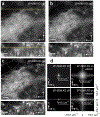Adaptive optics improves multiphoton super-resolution imaging
- PMID: 28628128
- PMCID: PMC7749710
- DOI: 10.1038/nmeth.4337
Adaptive optics improves multiphoton super-resolution imaging
Abstract
We improve multiphoton structured illumination microscopy using a nonlinear guide star to determine optical aberrations and a deformable mirror to correct them. We demonstrate our method on bead phantoms, cells in collagen gels, nematode larvae and embryos, Drosophila brain, and zebrafish embryos. Peak intensity is increased (up to 40-fold) and resolution recovered (up to 176 ± 10 nm laterally, 729 ± 39 nm axially) at depths ∼250 μm from the coverslip surface.
Figures



References
Publication types
MeSH terms
Grants and funding
LinkOut - more resources
Full Text Sources
Other Literature Sources
Molecular Biology Databases

